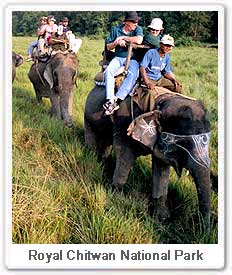Major Attractions : One-Horned Rhino, Royal Bengal Tiger.
Area Covered : 932 sq-km.
Ideal Time to Visit the Park : Through out the year.
Nearest Attractions : The Elephant Breeding Center at Khorsor in Sauraha; The museum at Kasara; Gharial Breeding Center
Some Major Accesses : Kathmandu, Bharatpur.
Things to Know
Where is the Royal Chitwan National Park
 Royal
Chitwan National Park is situated in the flat lowland region of southern
Nepal, just close to the Indian boundary. Royal Chitwan National Park is one
of the most important sub-tropical parks on the Indian subcontinent with
good populations of the endangered Royal Bengal tiger, Greater One-horned
rhinos, Gangetic dolphin (Platanista gangetica), Wild Asian elephant, Gaur,
Golden Monitor lizard, Gharial crocodile and many more.
Royal
Chitwan National Park is situated in the flat lowland region of southern
Nepal, just close to the Indian boundary. Royal Chitwan National Park is one
of the most important sub-tropical parks on the Indian subcontinent with
good populations of the endangered Royal Bengal tiger, Greater One-horned
rhinos, Gangetic dolphin (Platanista gangetica), Wild Asian elephant, Gaur,
Golden Monitor lizard, Gharial crocodile and many more. The Climate in the Royal Chitwan National Park
The Royal Chitwan National Park has a range of climatic seasons, each offering an unique experience. October through February with an average temperatures of 25 degree centigrade offer an enjoyable climate. From March to June temperatures can reach as high as 43 degree centigrade. The hot humid days give way to the monsoon season that generally lasts from the late June until September. Rivers become flooded and roads are inaccessible during this period.
Important Dates in the Royal Chitwan's History
The Chitwan region has had a long history of conservation. For many years the Royal Chitwan Park was the Royal hunting grounds for the Kings and dignitaries of Nepal. It did however become a favourite spot for big game safari hunters in the late 19th and early to mid-20th centuries. The long-term hunting led to a drastic decrease in jungle habitat and animal populations in the Chitwan valley as jungles were converted to farmland and big game were hunted and poached to dangerously low numbers. The falling number of rhino and tiger in the present park region, focused attention on the Chitwan region and in 1963 the southern two-thirds of the park were declared as a Rhino Sanctuary. With sanctuary status came a moratorium on hunting and the relocation of 22,000 people from the Chitwan valley. Since 1963 wildlife populations and ecosystems have been rebounding. In 1973 Chitwan became Nepal's first National Park. The relatively pristine state of the modern park and its unique ecosystems prompted UNESCO to declare the park a World Heritage site in 1984.
The Ecological System in the Royal Chitwan National Park
The Royal Chitwan National Park inhabits more than 50 mammal species, over 525 birds, and 55 amphibians and reptiles.
The Landscape in the Royal Chitwan National Park
The park has a diverse ecosystems, which includes the Churia hills, ox-bow lakes, and the flood plains of the Rapti, Reu and Narayani Rivers. The Churia hills rise slowly towards the east from 150 m to more than 800 m. The western portion of the park consists of the lower but more rough Someshwor hills. The park shares its eastern boundary with the Parsa Wildlife Reserve.
The Flora in the Royal Chitwan National Park
The Chitwan valley features tropical and subtropical forests. Sal forests cover 70% of the park. Grasslands is spread in the 20% of the total park area. There are more than 50 various types of grasses, including the elephant grass (Saccharum spp.), known for its height (can grow up to 8 m in height). The shorter grasses (Imperata spp.) are also found here.
The Fauna in the Royal Chitwan National Park
The endangered fauna found in the park are - One-horned rhinoceros, Gaur, Royal Bengal tiger, Wild elephant, Fourhorned antelope, Pangolin, Gangetic dolphin.
The Avifauna in the Royal Chitwan National Park
The birds found in this park are - Bengal florican, Lesser florican, Giant hornbill, Black stork, White stork, etc.
The Reptiles in the Royal Chitwan National Park
The reptiles found here are - Gharial crocodile, Golden monitor lizard, Python, etc.
The Rides in the Royal Chitwan National Park
Elephant Safari
Elephant Safarai is the best way to explore the Royal Chitwan National Park. Elephant safari provides an opportunity to get a closer view of the endangered one-horned Rhinoceros. One may also get a glimpse of the majestic Royal Bengal Tiger.
Royal Chitwan Park Travel Circuit
Kathmandu - Chitwan - Pokhara - Nagarkot
How to Reach Royal Chitwan's History
Air : There are daily flights from Kathmandu to Bharatpur.
Road : Chitwan is easily approachable from Kathmandu, which is well connected by national highway to Bharatpur and Saurana






